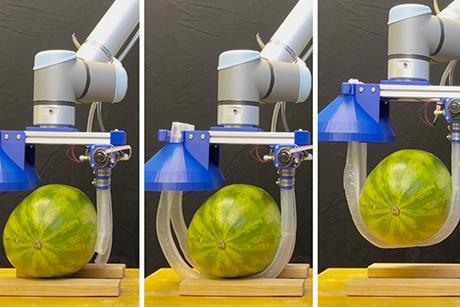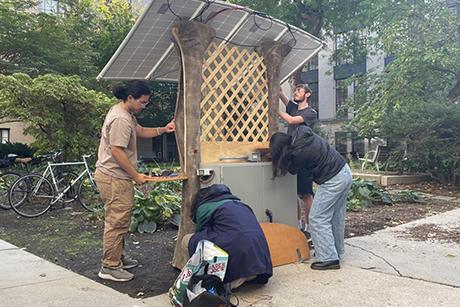Materials’ Key Role in Addressing Climate Change is Focus of Materials Day Symposium
Eco-friendly cement, textiles designed for easier recycling, and databases for the prediction of new materials with less of an impact on the environment were among the many examples of work aimed at cutting materials’ contributions to climate change described at Materials Day 2021, a symposium on October 20 held by MIT’s Materials Research Laboratory.
About 200 people registered to attend the event in person at Kresge Auditorium, while almost 500 registered to watch it online.
“Materials play a central role in all aspects of the new technologies needed to achieve sustainability goals and address climate change,” said Elsa Olivetti in opening remarks. To get there, however, we must move quickly, said the Esther and Harold E. Edgerton Career Development Professor in the Department of Materials Science and Engineering. “To meet the climate targets we set for 2050, all of our new systems must be low- or no-emissions by the end of this decade if not much sooner….So we need solutions fast, and we need them to be effective.”
In addition to the urgency of this challenge, other themes repeated throughout the day included the need for interdisciplinary collaborations. For example, Caitlin Mueller, an associate professor in the Department of Civil and Environmental Engineering (CEE) and the Department of Architecture who specializes in sustainable architecture, emphasized the need for architects and engineers to work together much more closely, especially “very early on in the design process [when] we can have big impacts on building performance and material efficiency.”
Another theme that Olivetti noted is that we must “link what’s happening at an atomistic scale to what’s happening within an industrial context.” Reducing emissions from all steps in the transformation of a raw material into a product “requires that we think about these [different] length scales all at the same time.”
Sustainable Materials Design
Desiree Plata works on the development of novel chemicals, materials, and engineered systems with a focus not only on performance and cost, but also environmental impacts. She noted that there is often a 20-year gap between the introduction of a new material, like nanotubes, and assessments of their environmental impacts. That’s a problem because by that time, “we’re going to have committed ourselves to decisions we can’t undo because of infrastructural costs, or environmental damages we can’t fix because it’s too hard to remediate chemicals in the environment,” said the Gilbert Winslow Career Development Associate Professor of CEE.
Plata suggested several ways to close the gap between material innovation and environmental assessment. In addition to implementing environmental assessments much earlier in the process, she encouraged innovators to “partner with an environmental scientist or engineer who can help you do that assessment.”
Other ways to close the gap include high-throughput experimentation to get a faster understanding of the fate, toxicity, and performance of new materials. Plata also emphasized that we need better fundamental science to understand how a material’s structure impacts both its functional performance and potential environmental hazard. “That will help us think about whether those two things can be decoupled, or whether they’re fundamentally stuck together and we need to pivot to a new material system.”
Plata further cited the importance of materials-selection databases, and said that work toward “coordinated and interoperable datasets will [also] be transformative.” With respect to the latter, she cited the work of Bradley Olsen, the Alexander and I. Michael (1960) Kasser Professor in the Department of Chemical Engineering. Later, Olsen described his work to predict what monomers to make in the search for more biodegradable polymers.
Materials in the Textile Industry
From the clothes we wear to the rugs we walk upon, textiles are key to our lives. And the quantities produced “are doubling every 20 years,” said Gregory Rutledge, the Lammot du Pont Professor of Chemical Engineering. The enormous industry also has major effects on the environment. “It’s responsible for an estimated four billion metric tons of CO2 equivalent per year, or five to 10 percent of global greenhouse gas emissions,” Rutledge said. As a result, “if you can make a small difference in the industry you might really be able to move the needle on climate effects.”
Rutledge went on to describe specific strategies for reducing the industry’s environmental footprint. They include:
--Reducing the resource-intensive nature of the industry by, for example, finding alternatives for especially energy-intensive processes like dyeing and finishing.
--Reducing overall production volume. 3D knitting, for example, could reduce the amount of scraps created in creating a garment. More efficient manufacturing through customization and the reduction of overstocks could also help. Rutledge emphasized that the consumer can also play a role by increasing the number of times they wear a piece before throwing it away (the typical garment is only worn about eight times). “If you double the number of uses, presumably you can halve the number of products you need to make each year.”
--Transitioning from a linear to a circular economy. Here Rutledge referred to what he calls Re-X: reusing, repairing, and recycling textiles.
Rutledge went on to describe examples of MIT research that could have an impact. For example, Svetlana Boriskina, a principal research scientist in the Department of Mechanical Engineering, is developing “smart” polyethylene fibers with a variety of different properties. These range from fibers with a strength similar to the materials in bullet-proof vests to very elastic fibers (think shapewear). Polyethylene is readily recyclable, so these fibers could potentially replace those that aren’t.
Eco-Friendly Cement
The production of cement, which binds together stone particles to form concrete, is responsible for roughly eight percent of worldwide carbon-dioxide emissions. And its use is on the rise. “If you look at the current rate of construction globally, by 2060 the number of buildings will have doubled. That’s the equivalent of building out one New York City’s worth of cement every 30 days over the next 40 years,” said Yet-Ming Chiang, the Kyocera Professor in the Department of Materials Science and Engineering.
Chiang went on to describe how new electrical processes using electricity from renewables could be one way to decarbonize cement production. He focused on a technology developed at MIT and now being commercialized by the startup Sublime Systems. The electrochemical process uses acid and base reagents to decarbonate the limestone that is key to cement. Although the process releases carbon dioxide, the gas is easily sequestered.
Chiang further noted that the byproducts of the process can in turn be used for other processes. For example, you can use them to make liquid fuels. Even the carbon dioxide can be “upcycled” for other uses, “instead of simply sequestering it.”
Just a few months ago, Chiang said, Sublime Systems produced its 100th laboratory formulation of cement. “We’re trying to show that this is a process that could lead to cement with the same composition, form, and function as today’s Portland cement, and we’re getting very close.”
He concluded by holding up an object about the size of a coffee cup. “This is Tim the beaver [MIT’s mascot] made out of fully decarbonized cement.”
Other principal speakers at Materials Day 2021 were Donald Sadoway, the John F. Elliot Professor of Materials Chemistry in the Department of Materials Science and Engineering (DMSE); Asegun Henry, an associate professor in the Department of Mechanical Engineering; and Antoine Allanore, an associate professor in DMSE.
The Materials Research Laboratory serves interdisciplinary groups of faculty, staff, and students, supported by industry, foundations, and government agencies to carry out fundamental engineering research on materials. Research topics include energy conversion and storage, quantum materials, spintronics, photonics, metals, integrated microsystems, materials sustainability, solid-state ionics, complex oxide electronic properties, biogels, and functional fibers. Its director is Carl Thompson, the Stavros Salapatas Professor of Materials Science and Engineering in DMSE.
Original Article from Materials Research Labratory

